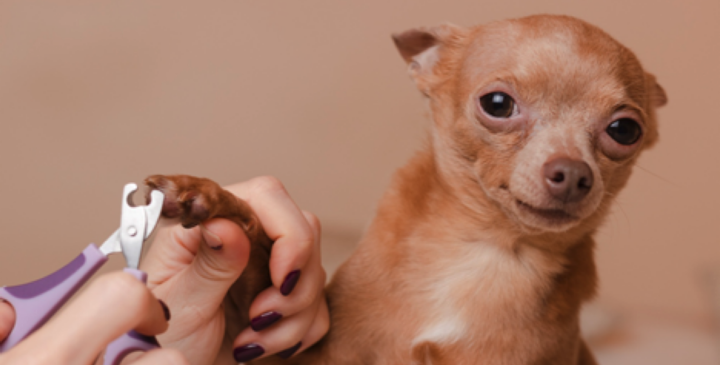How to Trim Your Dog’s Nails Safely

Contents
Nail trimming plays a massive part in the healthy grooming routine of your four-legged friend. Besides looking gross, long nails are pretty painful for your furry companion. Long nails are pushed back when they walk, creating unnecessary pressure on the nail bed that is extremely painful for the toe joints and can even lead to arthritis.
Long nails negatively affect the posture and gait of your dog, which is irreversible. Moreover, they can accidentally break, resulting in excessive bleeding.
On the other hand, clipped nails are a sign of your dog’s good health and hygiene. Also, there would be no more scratches and snags on your furniture and floor. So it is crucial to keep your furry friend safe and relaxed by adding nail trimming to your dog’s regular grooming schedule.
But unfortunately, your super active fur baby will not sit long enough until you get done clipping their nails. This makes nail trimming a daunting task for squeamish owners who prefer going for professional groomers to do the job for them.
Although the process is anxiety-laden for your dog, you can make it easy and stress-free by following the suitable method and the right equipment.
Here we will walk you through a safe procedure of trimming your dog’s nails without spending your hard-earned money on professional groomers;
After reading this guide, you will be able to answer the following;
- How to get your dog accustomed to nail trimming?
- How to safely trim your dog’s nails?
- What are the right nail-trimming tools for your dog?
- How much should you cut your dog’s nails?
- How frequently should you cut your dog’s nails?
- How to stop if toenails start bleeding?
- How to cut nails if they turn black?
- What are nail-trimming alternatives for dogs?
Get Your Dog Accustomed To The Process
Dogs can get on your nerves if you start clipping their nails out of sudden. They get frightened and try to escape, making the process an uphill battle for you.
You might have the rarest pups who quickly get comfortable with nail trimming, but if your pup takes longer, worry not! Almost every dog takes some time to get comfortable with the process.
Some breeds need more nail trimming schedules than others because their nails grow faster. For instance, a basset hound has thick nails that grow magically fast, so it would be better to trim their nails every week.
Given basset hounds are dogs that are highly adaptive and can quickly learn, there are many basset hound rescues for adoption. These breeds quickly get accustomed to changes, whether a new guardian or a new tool, as long as you take the time to bond with them.
So, the best in your interest is to keep touching and holding their paws right from day one. This makes them accustomed to having their feet handled.
- Step 1: Plan hearty conservation between your dog and the nail clippers. Reward them after a successful meetup.
- Step 2: Lightly touch the nail clipper with your dog’s paws. Give treats or toys and praise them.
- Step 3: Again touch the clipper with their paws and use the clipper without actually cutting the nails. Let your pup hear the sound of the clipper or vibrations of the grinder.
- Step 4: Trim just the tip of one nail with gentle hands, and give a lot of treats and hugs if they let you play with their feet. Repeat the process daily until they stop being an angry young man.
- Step 5: Add one more nail to the process and repeat the process next few days.
- Step 6: Keep working on it, adding the nails each day until you cover them all and your puppy has no trust issues. Then stick to the schedule, so your dog gets accustomed to the process.
Tools you need for Trimming Dog Nails
Unlike an overwhelming pedicure toolkit of humans, dogs need three essentials for their nail trimming. Keeping these tools handy will be enough to groom your dog’s nails safely.
- Nail clippers/grinders
- Treats
- Styptic powder
Types of Nail Clippers
Only use the nail clippers designed for pet use. Dog guardians come across a plethora of options while choosing nail clippers. Some are comfortable with guillotine-type clippers, while others favor spring-loaded ones.
Vets and professional groomers recommend using spring-loaded nail clippers and plier-style clippers if you can find nail clippers that contain a guard to protect from cutting the sensitive part of your dog’s nails.
The most common nail clipper types you would find in a flea market are;
-
Scissor clippers
They are similar to scissors, but the blades are shorter and sturdier to cut thick and hard nails easily. Scissor clippers can work on small and large breeds, but they go well with large dogs.
If you have a miniature dog, wearing nail clippers specifically designed for small breeds would be more favorable.
-
Guillotine clippers
This type of clipper contains a small loop containing blades on the edges. Insert your dog’s nail; the blades will cut the nail in one go. This one is perfect for your pooch if you have a small breed.
Also, clippers come in different sizes, so choose one that seems suitable for your dog’s nails. After a while, these clippers will fade their sharpness, so you need to sharpen them or replace the new ones.
Treats
Your dog’s favorite treat is the only bribery for enticing them to behave like a gentleman. When they sits comfortably in nail trimming sessions, reward them with treats, hugs, and praises. This will motivate them not to think about getting off the track.
Styptic Powder
It would help if you had clippers to cut your dog’s nails and a treat for letting you do so. But one more thing you should have on your bucket list; styptic powder or cornstarch.
It would help if you had them when you accidentally cut the quick. A blood vessel, named quick, runs through your nails, and if you miss the nails too short, your blood vessel might get cut too. Your dog’s nail will start bleeding, so apply the styptic powder or cornstarch to stop the bleeding.
If their nail does not stop bleeding, contacting experts like Bond Vet telehealth vet for help would be appropriate to prevent any serious infection to spread. As the safest option, always cut the ends of the nails to avoid reaching out to the quick and hurting your canine friend.
Safest Way of Dog nails Trimming
Let your dog sniff the clippers and hear the sound of clippers. This will help your dog become accustomed to the procedure and smoothly get along. Once they are comfortable, follow the steps mentioned below;
- Find the quietest and most undisturbed corner of the house.
- If you are having a little pooch, hold them in a lap or a flat surface while taking help from another person if you are going to groom the large dog.
- Firmly hold the paws of your dog but with soft hands.
- Press their toe pads with your thumb while using your forefinger on top of the toe.
- Remove the hair if it is blocking you from seeing the entire nail.
- Push the paw pad with your thumb and forefinger backward to extend the nails.
- While your dog is not moving, cut only the tips of the nails and do not go beyond the natural curve.
- Give them many of their favorite treats at the end to link nail clipping with the reward.
Safest Way of Filing Dog Nails After Trimming
Nail clipping may leave sharp or fragmented edges at the end, so the best way to get rid of them is by using a file. Take a high-quality nail file, hold the paws gently, separate the toes, and apply the file to get smoother edges.
Safest Point of the Cut
It is recommended not to surpass the natural curve of the nail because this place contains quick, that is, the blood vessel, and cutting it will result in excessive bleeding and pain. The safest distance is 2mm away from the point where the quick begins.
This curved line is visible on your dog’s nails. If you have any confusion regarding the curved line, leave that nail a bit longer or take the help of a professional groomer as the safest option.
Trimming the Black Nails
The problem while trimming dog nails occurs if your dog’s nails are pigmented because now you cannot see that curved line. But luckily, there is another cue for you- a black ring surrounding the quick. But if you can’t see that white ring, ask your vet or any vet clinic employee to guide you.
Frequency of Nail Trimming
How often should you trim your dog’s nails? It depends on the growth rate of your dog’s nails or how frequently they wear out.
Typically, it would help if you took a gap between the clipping sessions of no more than three weeks, but it would be wrong to do it ahead of time. Your pooch’s nails should not be long enough to touch the ground. The more you take care of your dog’s nails, the more they will get used to the process. I recommend following a consistent nail-trimming routine because pets love to track their performance.
Dog Trimming Alternative
As an alternative to cutting your dog’s nails down, some people take the aid of a grinder designed specifically for pets. Hold their paws softly but tightly and grind only the tiny portion of the nail at first.
Unlike nail clippers, start from the bottom of the nail and then move up to the top, smoothing the edges afterward. Also, ensure dog hair does not get stuck in the grinder and hurt your pooch. Finally, hold the top of the grinder for better control.
Key Takeaways
Your canine friend needs your attention and time to fulfill their grooming needs. Cutting your dog’s nails will serve the hygiene element and avert the horrible scratches on your furniture and floor.
Get your dog accustomed to the nail clippers and grinders as early as possible. If they’re scared by the sounds of clippers, follow the step-by-step procedure mentioned above to get them used to the nail clipping process.
Do not pass through the curved line of nails because the blood vessel (quick) is laid down here. Otherwise, your puppy’s feet will be all in blood. So instead, try to make a nail-trimming routine and then stick to it.
Nothing is more important than the precious life of your furry friend, so do not compromise on their grooming needs. But, of course, this is the least they expect from their guardian!
